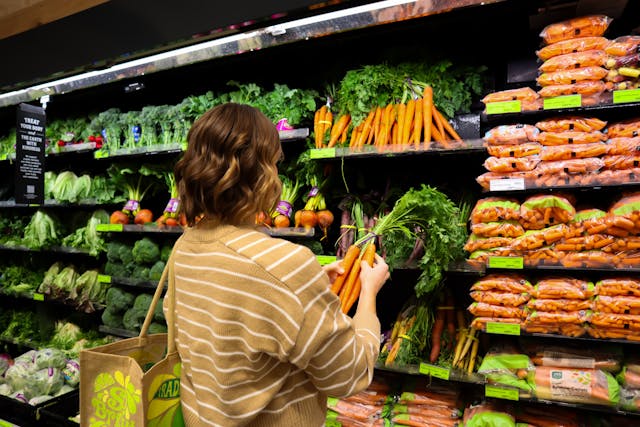This is a sponsored guest post.
A well-organized grocery list is one simple way to choose foods that support overall wellness. Knowing what to keep in your kitchen helps you plan meals, prepare snacks, and avoid last-minute decisions. Whether you’re stocking up for a week or building a long-term pantry, certain items are helpful to keep on hand. From fresh produce to pantry staples, every choice can contribute to a more balanced lifestyle.
This article walks you through some helpful categories to think about the next time you’re shopping.
Choose a Colourful Range of Fruits and Vegetables
Produce is one of the most important sections to focus on. A variety of fruits and vegetables brings both flavor and function to your meals. Leafy greens like spinach, kale, and romaine can be added to salads, wraps, or smoothies. Carrots, bell peppers, and cucumbers are easy to slice and enjoy raw. For fruit, apples, bananas, and oranges make easy snacks, while berries like blueberries and strawberries are great in oatmeal or yogurt.
Buying fresh is great, but frozen options are also convenient and last longer. Keeping a mix on hand can make it easier to prepare meals at any time of day.
In addition to eating a range of fruits and vegetables, some people include health-friendly supplements, such as the ones by USANA Health Sciences, in their routine. When paired with a nutritious diet, these supplements may support overall well-being. They are designed to complement food choices—not replace them—and can be part of a consistent, wellness-focused lifestyle.
Add Whole Grains to Your Weekly Plan
Whole grains are an easy way to add variety and fiber to your meals. Oats are great for breakfast and can also be used in baking. Brown rice and quinoa make filling side dishes or can be added to bowls and salads. Whole grain bread and wraps can be used for sandwiches or wraps.
Grains that contain fiber can help support regular digestion and help you feel satisfied after meals. When reading labels, look for whole grains listed as the first ingredient. This shows that the product uses grains in their more complete form, which can support your nutrition goals over time.
Keep Lean Protein Sources Ready to Use
Protein helps support muscle maintenance and is a key part of balanced eating. Plant-based proteins such as lentils, chickpeas, and black beans are easy to cook and can be added to many meals. Tofu is another versatile option that absorbs flavor well and can be used in stir-fries or grilled dishes. For animal-based options, eggs, fish, and poultry are common choices.
Canned or dry beans can be stored well and are convenient to keep in the pantry. Including different protein sources in your meals helps you stay full and adds flavor and texture to your recipes.
Include Nourishing Fats in Your Meals
Fats play an important role in a balanced eating pattern. Certain fats, like those found in avocados, nuts, and seeds, are often included in wellness-focused grocery lists. Olive oil is also a common item that can be used in cooking or salad dressings.
Foods that contain unsaturated fats, such as almonds or sunflower seeds, can be included in snacks or meals. These fats are part of what makes meals satisfying. Foods that contain unsaturated fats, such as almonds or sunflower seeds, are often included in meals that are part of a wellness-focused lifestyle.
Pick Dairy or Fortified Plant-Based Alternatives
Milk, yogurt, and cheese are common grocery items. For those who prefer non-dairy options, plant-based milks made from soy, almonds, or oats are widely available. Many of these are fortified with calcium and vitamin D.
Calcium helps support bone health, and vitamin D helps the body absorb calcium. These nutrients can be found in dairy as well as many fortified non-dairy items. Choose plain or unsweetened versions when possible to reduce added sugar in your meals. Yogurt also pairs well with fruit or oats, making it an easy snack or breakfast base.
Pantry Staples That Add Convenience and Flexibility
A well-stocked pantry gives you more choices when preparing meals. Canned beans, such as black beans or lentils, are useful in soups, salads, and stews. Canned diced tomatoes can help you prepare sauces, stews, or grain bowls with minimal effort. Other helpful items include rolled oats, brown rice, whole grain pasta, and nut butter made from just nuts and a pinch of salt.
These ingredients are simple, shelf-stable, and can be combined in different ways depending on what you feel like eating. Pantry items also come in handy when you want to put a meal together quickly without a trip to the store.
Frozen Options That Help You Stay Prepared
Frozen foods can be just as useful as fresh ones. Frozen vegetables like broccoli, peas, or green beans are easy to steam or stir-fry. Frozen fruits such as mango, strawberries, or blueberries are good for smoothies, yogurt, or oatmeal. They’re picked and frozen at peak ripeness, which helps preserve their taste and texture.
You can also stock frozen edamame, chopped spinach, or pre-cooked grains like brown rice and quinoa. These options give you flexibility and save time on busy days. Having frozen options on hand also helps reduce food waste since they last longer than fresh produce.
Simple Snacks That Fit Your Routine
Snacks are part of everyday life, and having a few easy choices at home helps you stay consistent with your goals. Trail mix with nuts and dried fruit is quick to portion and easy to take on the go. Roasted chickpeas are crunchy and satisfying. Fresh fruit with nut butter is another easy option that can be prepared in minutes.
These types of snacks offer a mix of nutrients, like fiber, healthy fats, and protein. When choosing packaged snacks, look at the ingredient list to keep things simple. A short list with ingredients you recognize is often a good place to start.
Grocery shopping is more than just filling your cart—it’s part of how you support your everyday lifestyle. Stocking your kitchen with a mix of fresh produce, whole grains, lean proteins, and simple snacks can make it easier to prepare meals that work for your routine. Including frozen items and pantry staples also adds flexibility, so you always have something to reach for.
Whether you’re planning weekly meals or just trying to stay prepared, building a wellness-focused grocery list can help you stay aligned with your daily goals. Small choices made consistently can support the lifestyle you value.

Hi there! I am Emily Evert, the owner of Emily Reviews. I am 28 and live in a small town in Michigan with my boyfriend Ryan and our two pugs. I have a large family and I adore my nieces and nephews. I love reading memoirs, and learning about child development and psychology. I love watching The Game of Thrones, Teen Mom, Sister Wives and Veep. I like listening to Jason Isbell, John Prine, and other alt-country or Americana music. I created Emily Reviews as a creative outlet to share my life and the products that I love with others.
This post currently has no responses.







Leave a Reply